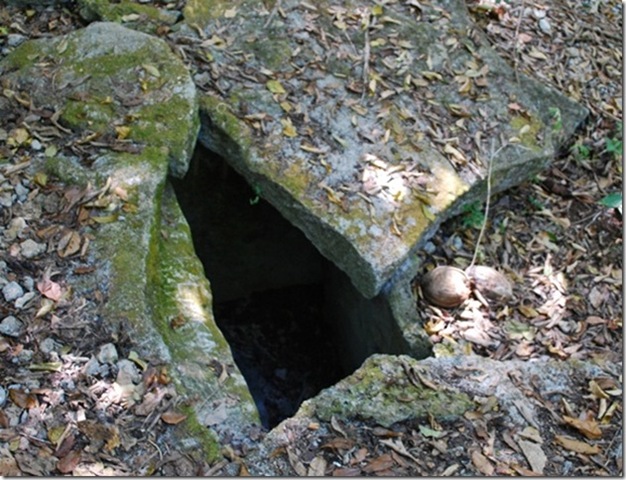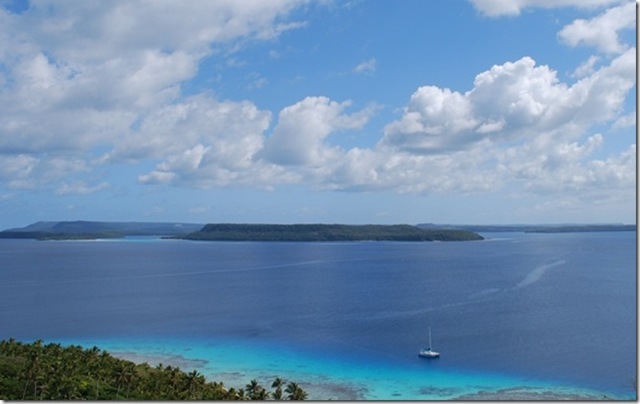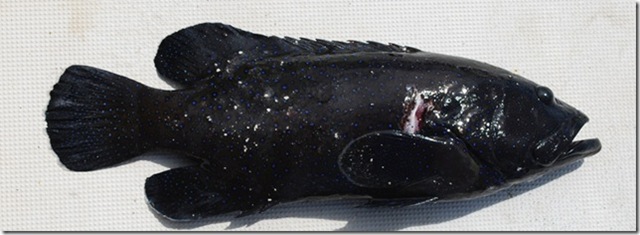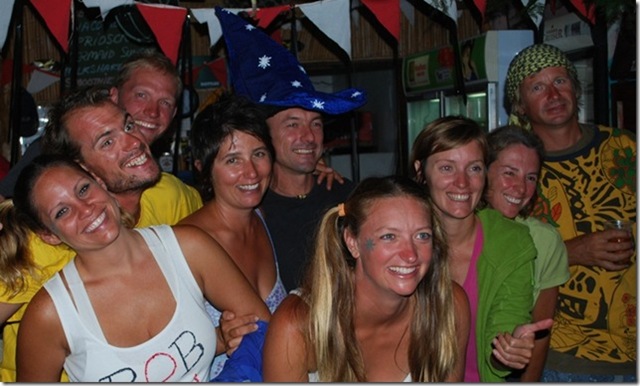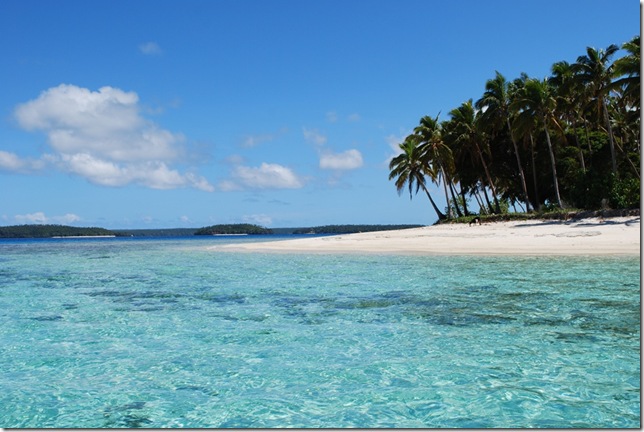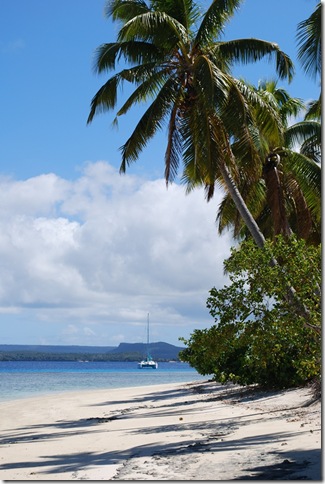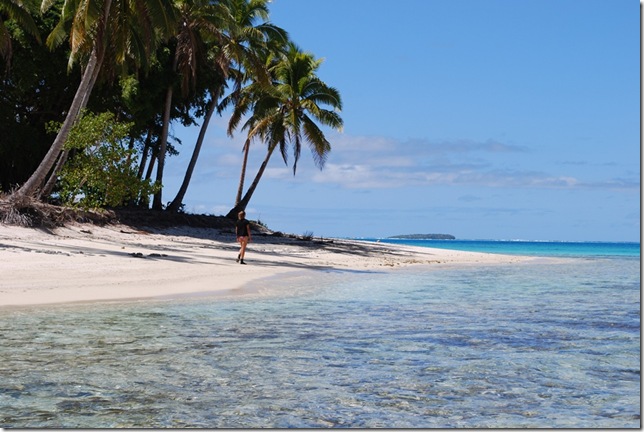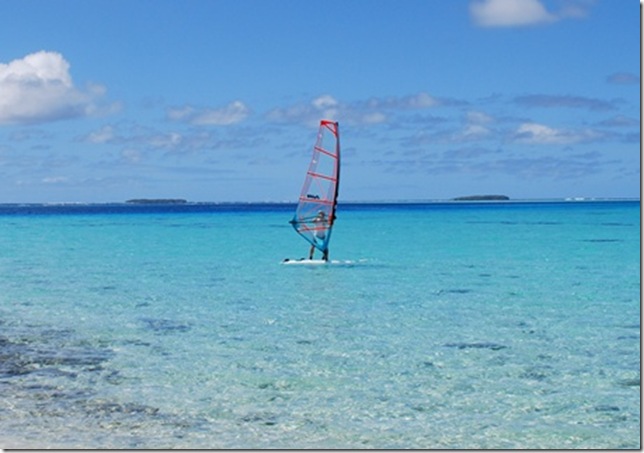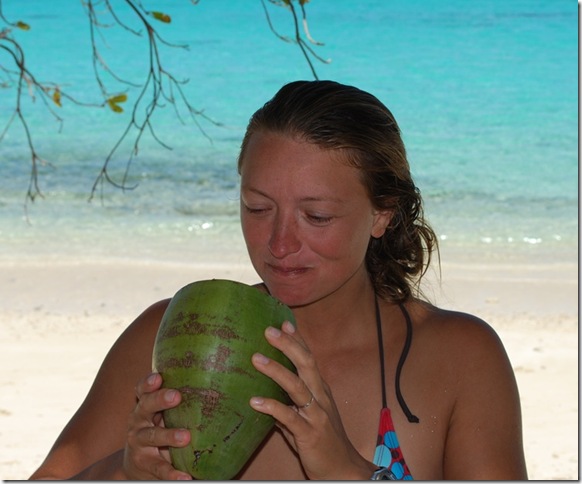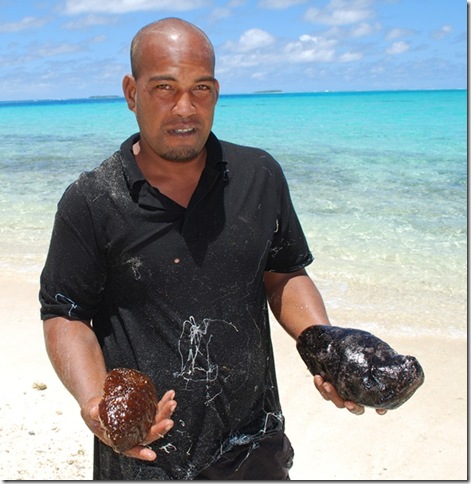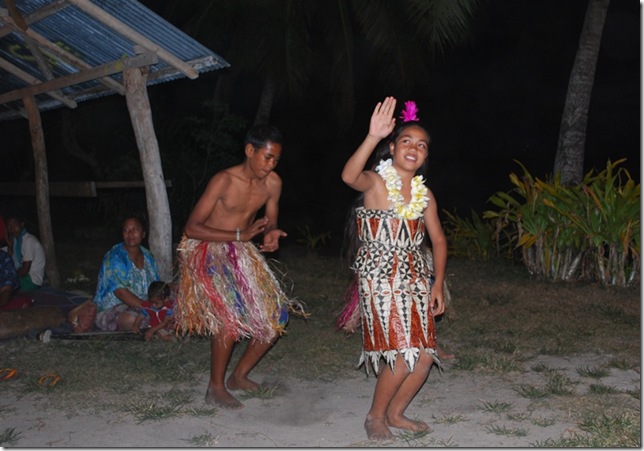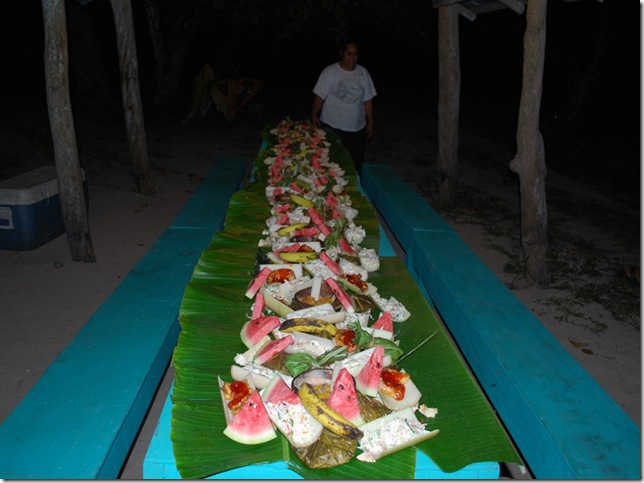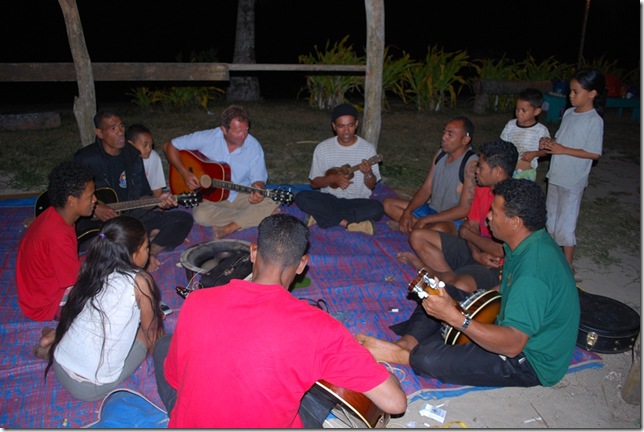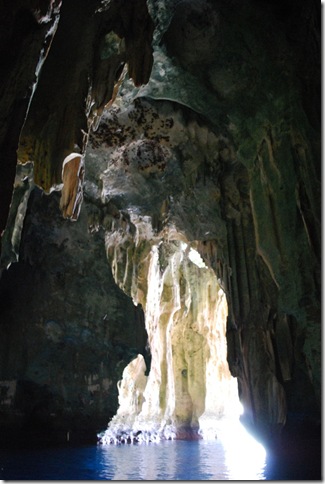We’re finally motoring out of Neiafu harbor and headed toward New Zealand. We’ll set a course for Minerva Reef, but if the weather looks good when we get there, we’ll probably keep going. We are headed out into a front that looks like it will make things rainy and rough for the next day and a half. Normally we’d stay put and wait it out, but the forecast looks like no rough weather on the second half of the way to New Zealand if we leave soon and make good time, so we’ll take some rough weather to start with and just try not to break anything.
I think we’re getting used to being in second and third world situations. I was just noticing yesterday as I was checking out how commonplace the attempt at collecting a bribe as a "fee", barefoot pedestrians, men in pareus, and pigs roaming the yards and streets have become. When we checked out with customs, our information was written in a large, tattered log book that was originally printed as an airport logbook, and from the looks of it, that was sometime in the 1940’s. It was probably part of a foreign aid package. Many of the government and municipal offices have labels of some sort indicating who donated the equipment or funds for construction. Both here and in Niue, many of the desks and computers in the immigration office had big blue EU stickers with a circle of yellow stars. The computers looked new, but the office furniture looked like it was surplus from a couple of decades ago.
Our planned passage time is 10-14 days to cover the approximately 1200 nm, so this will be our longest time out in a while. Hope everyone is doing well back in the states. We’ll keep you posted on the way and hope to have pics of our arrival up in a couple of weeks.
Monday morning we got up early (6 am!) and sailed back to Tapana / Ano Beach (anchorage #11) to do some work diving for Larry & Sheri at the Ark Gallery. They needed to do some seasonal maintenance and make some modifications to their moorings, and they aren’t divers, so Lauren and I wanted to help out and try work diving. Larry’s system of moorings uses heavy anchors (up to 150 lbs) and chain, with 4-6 connections per mooring instead of a heavy concrete block and short scope of rope. Most of the work involved moving anchors, connecting new pieces of chain between anchors and the mooring, and changing out the risers (rope connections with floats between the mooring swivel or ring and the surface). We had only planned on one day of work, but there was more than enough work for a second day, which worked out with our plans, so we worked Tuesday as well. Most of the work was in 30-50 feet of water, and we did the deeper stuff on the first day, carefully keeping track of our bottom time and surface intervals with our dive tables.
Overall, it was fun, but pretty exhausting. Removing and adding the well-greased shackles was generally pretty straightforward, but some of the work (dragging anchors, straightening & moving chain, etc.) involved a little exertion. Things are definitely lighter underwater, and I think our backs are in better shape than Larry’s, as he had to load and then slowly lower the chains from the work dinghy. After two weeks of beautiful, sunny weather, we’ve had two days of overcast skies and frequent light rains. Even though we followed all the rules for bottom time and ascending, spending a lot of time underwater for two days left me feeling exhausted and with some minor cold symptoms. Luckily, it doesn’t seem to be anything that can’t be remedied by a good night’s sleep.
Larry and Sheri turned out to be incredibly nice and very generous hosts. They are living proof that Americans can in fact have a humble existence without the need for credit cards, automobiles, internet access, etc. after living in their two-room “Ark” on the water for the last 10 years. In addition to trading some of Sheri’s art for our diving, Sheri fixed incredibly tasty and creative meals for us, and Larry even broke out his cold homemade beer. Although he insisted it was not as good as usual, we found it to be pretty tasty. I think the meals, beer, and conversation would have been payment enough. There was another long-time cruiser there named Brian who has sailed around the world and has his base in Fiji (keeps his boat there most of the time). They all have years and years of sailing experience, with some great stories about passages and interesting locales that they visited in more primitive times (Ua Pou had no roads when Larry and Sheri were there last). Their soft-spoken, humble demeanor about some truly impressive sailing resumes was pretty refreshing. It’s such a stark contrast with some of the types you meet in the waterfront restaurants and bars who are talking up the adventure and bravery involved in their passages. I think we’re somewhere in the middle – still a little impressed that we’re actually managing to do this while also starting to get used to passage making and beautiful “exotic” locales.
Tuesday night we headed for Port Maurelle (#8), a well-protected little bay where a Spanish captain named Maurelle became the first European to discover and land at Vava’u (Captain Cook stopped farther south in Tonga, but the visiting chief of Vava’u lied and told him there were no anchorages or harbors in Vava’u so he’d best not visit). The occasion was yet another party in Vava’u, this time a birthday party for Paul on S/V Disa. Yet again, the good aboard Disa was excellent – potato/onion soup, garlic bread, and fruit salad. The gathering on the boat was intimate and low-key by recent established standards, and luckily there was an empty settee for me to crash out on while the others socialized.
The anchorages here in Vava’u have been really nice in terms of how protected they are. In the high islands of French Polynesia, when the wind was blowing 20 knots, it would mean gusts of 30-40 knots or more coming down off of the mountains. Here the hills and cliffs actually provide considerable protection from the wind. The anchorages are so calm that I suspect we’re not going to be feeling too good when we finally leave here and head out into the open ocean with wind forward of the beam.
Our plans are to leave any day now for New Zealand. Today was supposed to be clear, but it’s still raining, which may delay our departure for one more day. We’re likely going to sail toward North Minerva Reef, which is a reef in the middle of the ocean very similar to Beveridge Reef. It’s about 400 miles or 1/3 of the way from here, and if the weather from there to New Zealand isn’t looking good, we can stop, enter the lagoon, and anchor while we’re waiting for a better weather window.
Our preparations for the passage are almost complete. We still have to check out, provision and stow things, but we’ve cleaned the bottom, changed the oil in both engines, practiced deploying the sea anchor, programmed emergency numbers into the sat phone, filled the fuel tanks, and found several weather sources in addition to the GRIB files to help us with planning. It’s not easy to get excited about leaving such a relaxed place in the tropics to sail 1200 miles into the higher latitudes, but we have plans for work and flights and it will be nice to have the passage completed and be able to spend several months with only day sailing trips.
Leo was remarking last night how time seems to stand still here. Without all of the seasons, holidays, school events, and sports seasons that typically mark the calendar, months go by and it’s hard to fathom that you’ve just spent all winter (as well as much of the spring and fall) in the islands and are now about to sail south for the summer.
Thursday was a busy day at Euakafa Island (#32). Dallas and I awoke early and climbed 300’ to the plateau at the top of the island. It was a fairly quick and easy hike to the top amidst a forest of varied foliage that characterizes the islands of Tonga. Near the top we located the open tomb that was mentioned in the cruising guide. Apparently it was the final resting place for a Tongan queen whose life was cut short by the chief’s henchmen as a result of her infidelity. We headed on up to the viewpoint at the top where we could see our boat and two others anchored in the clear aquamarine water surrounded by the deeper blue sea dotted with green islands. Unfortunately, we neglected to put the camera battery back in the camera after charging it, but Wes and Tiff hiked up the next day and snapped some really nice shots. I have to agree with the cruisers who refer to the Vava’u group of Tonga as the most idyllic cruising grounds.
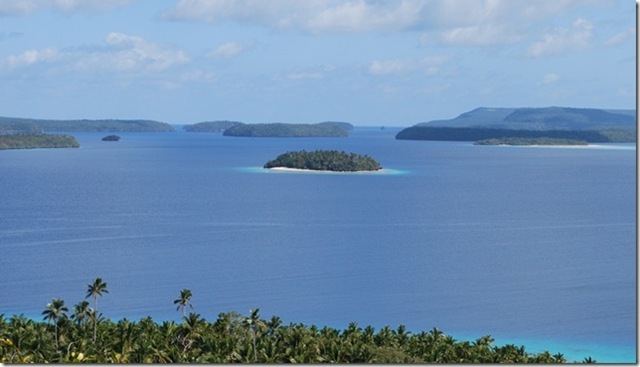 Neighboring islands of the Vava’u Group
Neighboring islands of the Vava’u Group
We returned to the boat to grab a quick snack and get our snorkeling gear, and then it was off to join the guys from the other two boats in trying to spear some fish for lunch. We all came back empty handed, blaming it on the dwindling fish population in Tonga, but Wes proved that it could be done by spearing a grouper later that afternoon.
Next it was time to get serious about preparations for the passage to New Zealand. I volunteered to do one last bottom-cleaning before the infamous bottom inspection by the NZ officials. (For the land-lubbers who may be a little perplexed right now, I’m talking about cleaning algae/barnacles off of the bottom of our boat, not scrubbing my backside!) I assumed that this would be relatively easy since we just cleaned the bottom in Niue, and it was, but after another couple of hours in the water, I was exhausted! Dallas was as well after rounding out the day by changing the oil on both engines. If we can keep this up, though, we should be ready to set sail early next week.
On Friday we continued our preparations by finishing up the bottom cleaning and practicing deployment of the sea anchor, a small parachute that is extended from the bow of the boat on 600 feet of nylon line. Its purpose is to keep boats virtually in place for reasons such as providing crew with a break from sailing and preventing collisions with reefs. We have never considered using it before but anticipate that it could be useful en route to NZ by allowing us to wait for rough weather to pass before proceeding.
Next it was time to head back to Neiafu for the final regatta of the 2009 cruising season. The local yacht club has been coordinating these friendly races on a weekly basis throughout the season, but this particular one was quite hyped up, leading 15 boats to participate. We weren’t planning on racing initially but were lured into it by an official challenge from our Swedish friends on S/V Disa. We recruited 13-year-old Lisa and her father from S/V Anyway and another friend to crew for us, and they were not only great sailors but really pleasant company as well. We sailed quite nicely upwind, topping off at about 7 knots, but as expected, most of the other boats were much faster in light winds. Those of us at the back of the pack (basically us, Disa, a couple of larger but heavy monohulls, and a tiny one) weren’t able to finish before the wind died altogether. There was not so much as a breeze as we struggled to cross the finish line, so it wasn’t very glorious but fun nonetheless.
 Catching up to Disa just ahead
Catching up to Disa just ahead
The subsequent Halloween party at the yacht club lived up to the hype as well. Of course costumes were encouraged (especially for the ladies…wonder why?), and Tiff and I made use of our limited available resources to dress up as the "Bob Sea Twins" with pigtails and matching tanks/jeans. It should have been adequate to get us a free rum punch were it not all gone by the time we got there. It was another late night for she and I as we whiled away the hours dancing to overplayed American top 40.
We met the crews of S/V Avel Mad and S/V Rusalka in Aitutaki
We’ve taken it pretty easy today, getting small tasks done (printing boat documents, going to the market) and going out to lunch with the brothers from Disa. Leo was a little bummed about losing his home-made lobster cage, thought to be sitting on the bottom 20′ below their boat. He would have gone to look for it were it not for his eardrum perforation problem, so I offered to fill in. The poor visibility (much different from the clear water of the uninhabited anchorages) prevented me from seeing the cage from the surface, so I used one of our scuba tanks to explore the bottom and located the cage just 10′ or so from where it likely went down. Leo was really pleased to have his cage back, and I could understand why after seeing the craftsmanship involved. He is hoping to use it to attract some unwitting lobster using Vienna sausages as bait. He was advised that dead fish might work better, but none of us have any laying around at the moment. With any luck he can snare a lobster with a diverse palate.
Tomorrow we will get more use out of our scuba gear, as Dallas and I are going to make good on our offer to help out the couple living on the floating house/art gallery at anchorage #11 by working on their moorings. I’m sure we could find plenty to do here in Tonga for many weeks, but we have to wrap things up and get ready to move on.
After a short stop in Neiafu for provisions, internet, water, and hanging out with friends yet again, we headed back out to the islands. The first stop was Avaldu Island (anchorage #40). Avaldu rests behind a large reef about a mile or so to the south, so the water is fairly calm. It’s uninhabited except for a small herd of goats, and has a beautiful beach on its west and south sides.
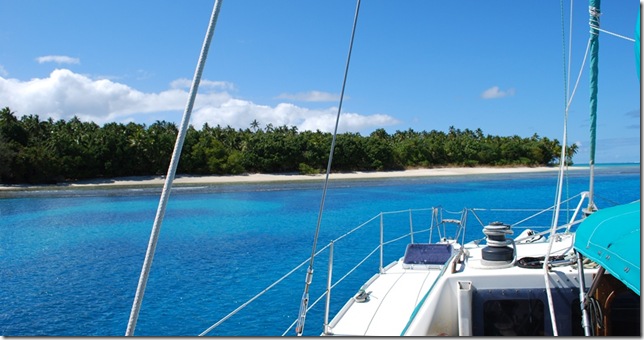 View of the beach from the boat
View of the beach from the boat
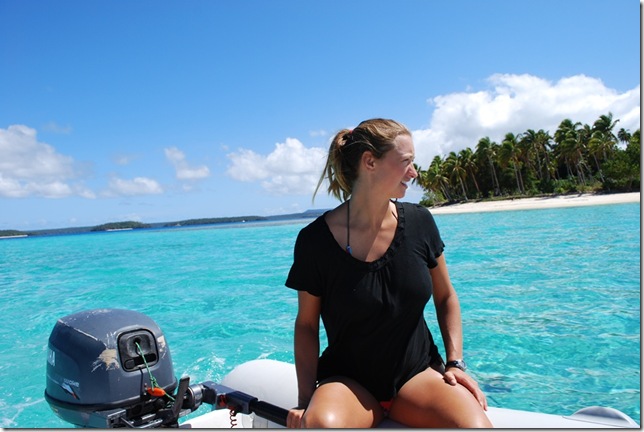 Lauren bringing us in to windsurf
Lauren bringing us in to windsurf
The French boat S/V Avel Mad joined us, and Ben is a good windsurfer. Since we had a nice beach with shallow water, the wind blowing us back toward land, and a day with no other exploring planned, we finally pulled out the windsurfer for a long overdue second lesson. Ben got us back up to the point we were after our first lesson with Ken back in Florida (more falling off than anything, but getting close to starting to sail), and the next morning we headed back to the beach for another round. This time, Lauren and I both did much better. The winds were light, and we need some more tips on what to do once you’re actually able to stand up with the wishbone in your hands, but we both sailed a short distance. I made it about 100 feet in the light winds, and found that being right-handed, the starboard tack is easier for me — it took me several tries to sail back to where I’d started.
While I was taking a break on the beach, a local swam around the southeast top of island and up to the beach dragging a couple of old rice bags tied to an empty anti-freeze bottle acting as a float. His name was Gopo and he was collecting cuttlefish to sell in Neiafu (8 panga each) where they’re apparently sold as a food item to Chinese buyers. While we explored the interior of the island a bit, he collected a number of young, green coconuts for us. The young, green ones are a bit harder to find but make a delicious energy drink. Gopo opened a couple of them, and they really hit the spot after a couple hours of trying to windsurf. We gave Gopo a ride in our dinghy out to the next reef so he could continue his collecting and then motored toward his friends on the fishing boat to signal to them and let them know about his new location. On the way back to the beach to pick up the windsurfer, I saw a whale off in the distance on the other side of the reef. Humpbacks are quite common here, and this one shot up into the air, looking like a submarine shooting up from deep water. It landed with a huge splash that dwarfed the breakers at the edge of the reef. It made a nice rolling fin-slap afterwards and then we didn’t see it again.
We made a short afternoon sail over to Euafaka Island (#32), following Avel Mad to our next stop as well. We arrived in a napping mood, and decided to leave exploring for the next day. Wes and Tiff came up with the idea of a nice dinner on the beach with a bonfire, so we all headed ashore with our food and wine in the cooler to enjoy a bonfire and dinner. The seemingly dry leaves here don’t light and burn quite as well as they did back home, so we enlisted the locally-used fire-starter — gasoline. A little gasoline from the dinghy on a paper towel did nicely and we soon had a nice little fire. Wes did a nice job providing music by connecting an FM transmitter to an mp3 player so we could listen to our own private FM channel on one of our radios. While we were enjoying the moonlit evening on the beach, we noticed lights in the water near our boat.. At first we thought maybe they were reflections of the moonlight or phosphorescence, but after a minute it was clear they were flashlights. Apparently the locals we had seen at the other end of the beach when we landed were swimming their way around the island’s fringing reef looking for lobsters. For the landlubbers, lobsters generally hide during the day and come out at night to scavenge, when they’re easily spotted crawling along the bottom, with eyes that reflect light like a specially coated highway sign.
The wind died almost completely while we were ashore, and when we returned to the boat, it was a really a beautiful sight. The water below the boat was nearly 30 feet deep, but it was so calm and clear that the gibbous moon provided enough light to see the rocks, coral, and contours on the bottom. It was like a real-life version of one of those paintings that shows the underwater view beside a beautiful beach and island above it. Of course there weren’t three dolphins, a whale, two manta rays, a starfish, and a sea turtle in view all at the same time like in the whimsical paintings, but it was a memorable sight nonetheless.
After a nice night in the cove by Lisa’s beach, we slowly got moving toward anchorage #11, near Ano Beach. Along the way, we stopped near Mala to anchor for lunch and a bit of snorkeling. When she got in, Lauren checked the anchor, and found that it wasn’t buried in the sand but had just snagged a piece of coral. We were only planning a short stop since it was an exposed, shallow area with a nearby lee shore, but it’s still nice to know what the anchor situation is. As usual, It held with no problems but it’s amazing how worried I’ve become about holding after dragging once in an anchorage with poor holding.
Lauren and Tiff tacked into the wind until we were just off of Ano Beach. They did a great job, but I did get a bit of a surprise when I woke up from my afternoon hobby and saw we were within a hundred feet or so of a cliff and getting ready to tack to back out. We dropped anchor in the bight to the east of Ano Beach, and waited as a steady stream of boats started coming in before sunset. Several of our friends made the trip over for the Tongan feast and it was nice to hear them on the radio and then see them pull up and drop anchor.
In all, about 25 people showed up for the Tongan feast, which started with some locals selling handicrafts while others started playing traditional music around a bowl of kava. The feast is a family business put on once a week in an outdoor beach setting, Things get started with several rounds of kids dancing while adults sit on the ground behind them drinking kava, playing guitars and wooden percussion instruments, and singing. The kids are good spirited and talented, with a nice variety of expressive dances. One of the boys ended the entertainment with some fire dancing, which was pretty impressive for someone his age. After the dancing, we settled down at the table setup under a tin-roof structure for the feast. There was raw fish, fried fish, fruit deserts, banana bread, corned beef, etc. Although there were some modern food selections, the presentation as very traditional. Banana leaves were used as tin foil, wrapping the baked items like banana bread and corned beef. The raw fish and cooked chicken dishes were served on sections of banana stalks cut in half to form a serving dish, and in the Tongan style, there was no silverware – all eating was done with bare hands. Afterward, the there was a short song session with Martin, some yachties, and the local musicians. As the next day was Sunday and the locals had to return home early, we had the beach to ourselves and enjoyed a nice bonfire on the beach until late into the night.
At the south end of the anchorage are some moorings an artfully painted, light blue floating home called the Ark Gallery. Larry and Sheri, two former cruisers from the US live there, rent the moorings, and sell Sheri’s painting as well as a few local handicrafts. We’d stopped the day before to have a look and we returned in the morning to select a painting and pick up a postcard. We had a nice conversation and the topic eventually turned to the New Zealand passage. Larry has done the passage 10-15 times, and feels that the cruisers these days leave much too early. Like others, he also told us that Haapi was nice (a more remote Tongan island group about 80 miles south) but that Nuku’alofa could be skipped without missing much (the Tongon capital about another 80 miles south of Haapi). It’s a large city with a small, crowded harbor and lots of unemployment. He also pointed out a couple of nice spots to visit that we haven’t seen yet.
After talking with Larry & Sheri, we went back to the boat and on the way back to Neiafu we all decided to spend the rest of our time in the islands in Vava’u and leave for New Zealand from here. It only adds an extra day or so to the trip and we still have plenty to see and do.
On the way back to Neiafu, we also stopped at Swallow’s Cave. Many of the islands here in Vava’u are limestone from upraised coral formations. Although the caves and cliffs aren’t generally as picturesque as Niue, they are pretty. Swallow’s Cave is a large cavern than you can row the dinghy into. There are nesting birds on the ceiling (apparently actually starlings instead of swallows) that were swooping in and out of the cave as we took turns paddling in while the other couple stayed to tend the drifting boat (even within one boat length of the cliffs, the water is more than 150 feet deep). Inside, there is a lot of graffiti (some of it dating back well into the 19th century), but but it doesn’t hide the beauty of the cavern with it’s vaulted limestone ceiling and elegant features or the incredible clear and glowing blue of the water below.
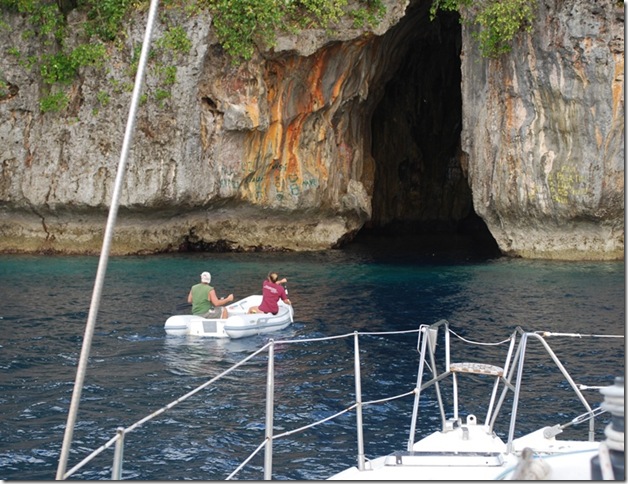 Wes & Tiff paddling toward Swallow’s Cave
Wes & Tiff paddling toward Swallow’s Cave
The only bad thing about Tonga is that there are so many cruisers here that we’ve met along the way or have gotten to know here that we are missing out on interacting with the locals. Even many of the waterfront businesses that cater to cruisers are run by expats.


